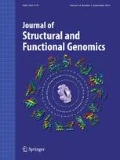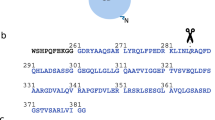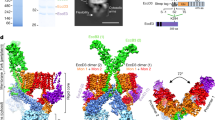Abstract
The Type VI secretion pathway transports proteins across the cell envelope of Gram-negative bacteria. Pseudomonas aeruginosa, an opportunistic Gram-negative bacterial pathogen infecting humans, uses the type VI secretion pathway to export specific effector proteins crucial for its pathogenesis. The HSI-I virulence locus encodes for several proteins that has been proposed to participate in protein transport including the Hcp1 protein, which forms hexameric rings that assemble into nanotubes in vitro. Two Hcp1 paralogues have been identified in the P. aeruginosa genome, Hsp2 and Hcp3. Here, we present the structure of the Hcp3 protein from P. aeruginosa. The overall structure of the monomer resembles Hcp1 despite the lack of amino-acid sequence similarity between the two proteins. The monomers assemble into hexamers similar to Hcp1. However, instead of forming nanotubes in head-to-tail mode like Hcp1, Hcp3 stacks its rings in head-to-head mode forming double-ring structures.



Similar content being viewed by others
Abbreviations
- T6SS:
-
Type VI secretion system
- Hcp1:
-
Hemolysin-corregulated protein
- PDB:
-
Protein Data Bank
- SeMet:
-
Seleno-methionine
- SAD:
-
Single-wavelength anomalous diffraction
- RMSD:
-
Root mean square deviation
References
Desvaux M et al (2009) Secretion and subcellular localizations of bacterial proteins: a semantic awareness issue. Trends Microbiol 17(4):139–145
Goodman AL et al (2004) A signaling network reciprocally regulates genes associated with acute infection and chronic persistence in Pseudomonas aeruginosa. Dev Cell 7(5):745–754
Ventre I et al (2006) Multiple sensors control reciprocal expression of Pseudomonas aeruginosa regulatory RNA and virulence genes. Proc Natl Acad Sci USA 103(1):171–176
Mougous JD et al (2007) Threonine phosphorylation post-translationally regulates protein secretion in Pseudomonas aeruginosa. Nat Cell Biol 9(7):797–803
Boyer F et al (2009) Dissecting the bacterial type VI secretion system by a genome wide in silico analysis: what can be learned from available microbial genomic resources? BMC Genomics 10:104
Mougous JD et al (2006) A virulence locus of Pseudomonas aeruginosa encodes a protein secretion apparatus. Science 312(5779):1526–1530
Pukatzki S, McAuley SB, Miyata ST (2009) The type VI secretion system: translocation of effectors and effector-domains. Curr Opin Microbiol 12(1):11–17
Bingle LE, Bailey CM, Pallen MJ (2008) Type VI secretion: a beginner’s guide. Curr Opin Microbiol 11(1):3–8
Schell MA et al (2007) Type VI secretion is a major virulence determinant in Burkholderia mallei. Mol Microbiol 64(6):1466–1485
Pell LG et al (2009) The phage lambda major tail protein structure reveals a common evolution for long-tailed phages and the type VI bacterial secretion system. Proc Natl Acad Sci USA 106(11):4160–4165
Leiman PG et al (2009) Type VI secretion apparatus and phage tail-associated protein complexes share a common evolutionary origin. Proc Natl Acad Sci USA 106(11):4154–4159
Ballister ER et al (2008) In vitro self-assembly of tailorable nanotubes from a simple protein building block. Proc Natl Acad Sci USA 105(10):3733–3738
Filloux A (2009) The type VI secretion system: a tubular story. EMBO J 28(4):309–310
Korolev S et al (2002) Autotracing of Escherichia coli acetate CoA-transferase alpha-subunit structure using 3.4 A MAD and 1.9 A native data. Acta Crystallogr D Biol Crystallogr 58(Pt 12):2116–2121
Minor W et al (2006) HKL-3000: the integration of data reduction and structure solution–from diffraction images to an initial model in minutes. Acta Crystallogr D Biol Crystallogr 62(Pt 8):859–866
Terwilliger TC (2003) SOLVE and RESOLVE: automated structure solution and density modification. Methods Enzymol 374:22–37
Morris RJ, Perrakis A, Lamzin VS (2003) ARP/wARP and automatic interpretation of protein electron density maps. Methods Enzymol 374:229–244
Emsley P, Cowtan K (2004) Coot: model-building tools for molecular graphics. Acta Crystallogr D Biol Crystallogr 60(Pt 12 Pt 1):2126–2132
Adams PD et al (2002) PHENIX: building new software for automated crystallographic structure determination. Acta Crystallogr D Biol Crystallogr 58(Pt 11):1948–1954
Hooft RW et al (1996) Errors in protein structures. Nature 381(6580):272
Davis IW et al (2004) MOLPROBITY: structure validation and all-atom contact analysis for nucleic acids and their complexes. Nucleic Acids Res 32(Web Server issue):W615–W619
Jobichen C et al (2010) Structural basis for the secretion of EvpC: a key type VI secretion system protein from Edwardsiella tarda. PLoS One 5(9):e12910
Acknowledgments
We thank all members of the Structural Biology Center at Argonne National Laboratory and at the Ontario Centre for Structural Proteomics for their help in conducting these experiments. This work was supported by National Institutes of Health grant GM074942 and by the U.S. Department of Energy, Office of Biological and Environmental Research, under contract DE-AC02-06CH11357 and by the US National Science Foundation grant MCB 0231319 (to R.H.W.), and by Genome Canada (through the Ontario Genomics Institute).
Author information
Authors and Affiliations
Corresponding authors
Additional information
The submitted article has been created by UChicago Argonne, LLC, Operator of Argonne National Laboratory (“Argonne”). Argonne, a U.S. Department of Energy Office of Science laboratory, is operated under Contract No. DE-AC02-06CH11357. The U.S. Government retains for itself, and others acting on its behalf, a paid-up nonexclusive, irrevocable worldwide license in said article to reproduce, prepare derivative works, distribute copies to the public, and perform publicly and display publicly, by or on behalf of the Government.
Rights and permissions
About this article
Cite this article
Osipiuk, J., Xu, X., Cui, H. et al. Crystal structure of secretory protein Hcp3 from Pseudomonas aeruginosa . J Struct Funct Genomics 12, 21–26 (2011). https://doi.org/10.1007/s10969-011-9107-1
Received:
Accepted:
Published:
Issue Date:
DOI: https://doi.org/10.1007/s10969-011-9107-1




